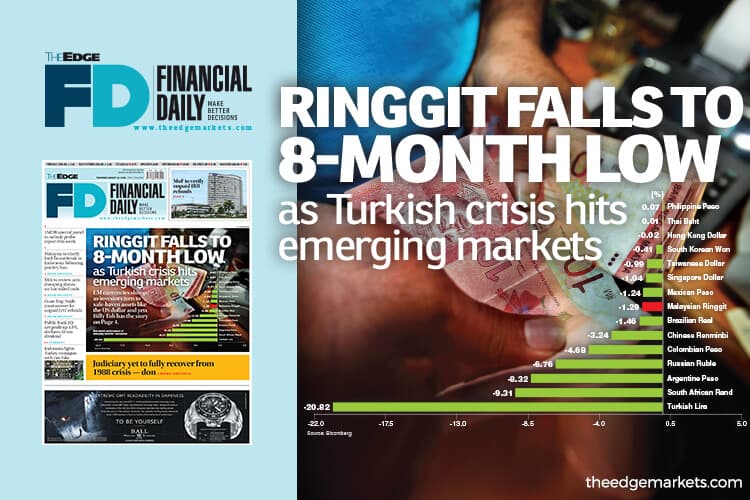
This article first appeared in The Edge Financial Daily on August 16, 2018
KUALA LUMPUR: The ringgit tumbled yesterday to an eight-month low against the US dollar as the currency crisis in Turkey continued to spook emerging markets (EMs), and the local currency is expected to remain under pressure with many economists predicting that it will fall further in 2018.
On Monday, The New York Times reported that Turkey’s crisis — caused by soaring inflation, economic mismanagement by the Turkish government and tensions with the US — has raised concerns over whether emerging economies that have benefited in recent years from foreign investment may also be vulnerable.
In just over a week, the lira has lost 6.6% of its value against the US dollar to hit a record low on Monday, and in August alone it has fallen by 28.6% against the greenback. The decline was also felt by other EM currencies as investors turn to other safe-haven assets like the US dollar and yen.
Yesterday, Indonesia’s rupiah touched a near three-year low while China’s yuan hovered around 15-month lows.
The ringgit, which has been under pressure over escalating concerns about the country’s fiscal deficit, slipped 0.2% to 4.104 against the US dollar. The local currency has fallen by 0.69% in August alone.
Still, it looks like Malaysians may have to fork out more ringgit if they plan make a trip to the US in the near term.
UOB Malaysia senior economist Julia Goh said the local currency is expected to remain volatile in the near term despite being one of the outperformers among Asian currencies.
“If you look at the ringgit, it is likely to remain volatile in the near term due to the uncertainties on the external front. Prior to this (the Turkish lira crisis), we have the trade conflict between the US and China that continues to escalate,” she told The Edge Financial Daily.
However, Goh pointed out that the weakness seen in the ringgit is reflective of the rest of the currencies in the region, indicating that the rally in the US dollar is likely to remain the dominant theme for now.
Nevertheless, Goh believes that the Turkish lira crisis is unlikely to cause contagion to the rest of the world, pointing out that it is very much an isolated incident.
Goh is predicting that the ringgit will trade at 4.08 against the US dollar by the end of the year. She had recently revised downwards her forecast for the ringgit due to the prevailing strong US dollar backdrop amid rising US-China trade tensions that put a renewed risk of weakness among Asian currencies.
The US dollar index spot rate has risen to 96.842, its highest level in over a year amid the Turkish lira crisis. Signs of a stronger US economy ahead of an expected interest rate hike by the US Federal Reserve have also led to the dominance of the US dollar so far.
Jameel Ahmad, global head of currency strategy and market research at FXTM, said the escalation of both diplomatic and trade tensions between the US and Turkey has reminded investors that it is not just the US and China that stand at the heart of the global trade war concerns.
“There are many other economies across the globe that feel aggravated by the protectionist nature of the Trump administration,” he shared in a note.
Will Trump’s tweets help to soften the US dollar rally?
In July this year, the US dollar index fell by 0.7% at 88.24 after US President Donald Trump commented on the US currency’s strength on Twitter.
“China, the European Union and others have been manipulating their currencies and interest rates lower, while the US is raising rates while the dollar gets stronger and stronger with each passing day — taking away our big competitive edge,” Trump tweeted at that time.
That had halted the rally of the US dollar, leading to the biggest one-day drop in three weeks at that time.
Jameel said he would be surprised if Trump does not repeat his discontent with the US dollar strength in the near future.
“One question that is emerging across the headlines for investors to take into account as the dollar hits another high for 2018 is — exactly how long can the dollar rally continue?
"A stronger dollar is the opposite of what the Trump administration wants to see, and there is an argument to be made that it offsets both the fiscal stimulus that Trump has encouraged alongside the protectionist policies as the price of imports into the US increases,” he added.